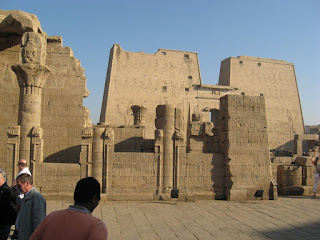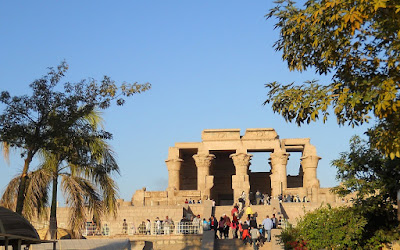We are now cruising the Nile to Upper Egypt. We sleep soundly and when we wake early, we see the full moon setting as dawn lightens the Nile.
After breakfast on the boat, we join Dalia to visit Edfu temple, a Ptolemaic construction. This site was, in ancient tradition the location of the mythological battle between the gods Horus and Seth, and its sandstone Ptolemaic temple is dedicated to Horus.
 |
| Edfu Temple, as depicted by David Roberts in the 1830s |
 |
| Edfu today |
This huge Ptolemaic temple was constructed over the site of a smaller New Kingdom temple, oriented east to west, facing towards the river. The newer structure faces north to south and leaves the ruined remains of the older temple pylon to be seen on the east side of the first court.
Interesting things about this temple include the language – like Dendera, the hieroglyphs look like what we have become familiar with, but the language is not Egyptian but Greek.
Also except for the entrances, the Egyptian workers, who for the most part held the middle Ptolemies in contempt, generally left the cartouches for them blank. This was safe to do because they could be confident that the Ptolemy pharaoh would not actually came here, and they could rely on only a cursory examination by any officials sent by the pharaoh. The fact the cartouche remain blank, as below, shows the workers were correct in their assessment.
The Greek influence is obvious here in the depictions of people – rather than idealized, here it is clear who is male and who is female.
The first gate shows the Pharaoh on each side, but on one he is wearing the crown of Upper Egypt and on the other, the crown of
This temple includes a wonderful series of scenes in the form of reliefs inside the entire outer wall of the temple. It is like a cartoon, from right to left, showing an on-going battle between Horus, son of Osiris, and Seth, Horus's uncle who murdered Osiris. In each scene Horus is in a boat using first a spear and then a spear and rope to try to kill Seth, who is depicted as a hippopotamus. At first Horus’s efforts have little effect, and then we see Seth inverted but not dead and then we see him up again and finally not dead but contained by ropes, controlled, as evil may be controlled but never eliminated from the world. Horus cannot kill Seth, cannot defeat him outright, but Horus can control him. It’s a parable – evil is always with us but we can strive to control it.
There re also the symbol of Ra-Horahkty - the winged sun disk - on the lintel which can also be interpreted as the triumph of good over evil.
We return to the ship and cruise another three hours, have a pleasant lunch and arrive at Kom Ombo. (Three hours on a ship is a lot easier than three hours on the road!)
The ship docks close to the temple of Kom Ombo and we meet Dalia to learn about this site. In ancient times, Kom Ombo stood on an important crossroads between the caravan route from Nubia and trails from the gold mines in the eastern desert.
This unusual two-sided temple, built not on an ancient religious site but at

Today this unusual two-sided temple, in an attractive setting right on the river bank with sugar canes fields all around, has been reassembled from the pieces
The temple is dedicated to two separate gods, Horus the elder and the local crocodile god, Sobek. (Some 40 crocodile mummies were supposed to be displayed in the adjacent museum, but that was not yet open - we later saw an enormous 18 foot croc mummy in the Egyptian Museum.) It has two entrances, two hypostyle halls, and two sanctuaries, completely symmetrical. It also has a little niche where you can pray to the golden image of your god. (Of course, the gold statues were the first thing to be looted from any temple.)
Attached to this temple is a sanatorium with wall depicting Imhotep (a physician, architect, etc., from Old Kingdom ) as a god of healing with a wash basin and surgical instruments, as well as two women in birthing chairs. How interesting that Imhotep become a god almost 3,000 years after he lived.
 |
On the left are two women using the traditional Egyptian birthing chairs.The medical instruments depicted here in the center seem rather sophisticated |
There is also a Nile-ometer, a common feature of temples throughout the ancient times – when the level of the Nile determined your tax rate – high water meant you could produce more crops, so higher taxes. Low flood would mean less productivity, so lower taxes.
So now it is back to the ship to cruise south up the Nile toward Aswan. This gives us an opportunity to watch Egypt going by.
We take the opportunity to bring our journals up to date, have dinner, and relax. After all the running during the past days, this is a pleasant respite.
 |
| There are about two hundred of these boats carrying tourists up and down the Nile |
 |
| More cabin boy sculpture! |
more pictures from today here: https://picasaweb.google.com/eloise.hedbor/20110122?authkey=Gv1sRgCNbd9eGKic7RpQE#













No comments:
Post a Comment